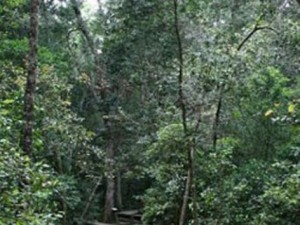 Conservation of the Knysna forests
Conservation of the Knysna forests
Where
Southern Africa: Southern South Africa
Biome
Tropical and Subtropical Moist Broadleaf Forests
Size:
1,200 square miles (3,100 square kilometers) – about the size of Rhode Island
Vulnerable
The Knysna and Amatole Mountain forests make up the Knysna-Amatole Montane Forest ecoregion, the southernmost Afromontane forest in Africa. There are a number of endemic birds, reptiles, and amphibians. However, these forests have a long history of human use. While timber harvesting is now conducted sustainably and the forests are recovering, habitat degradation and human influence mean that large mammal populations, including buffalo (Syncerus caffer), elephant (Loxodonta africana), and possibly the leopard (Panthera pardus), have largely been extirpated.
Location and General Description
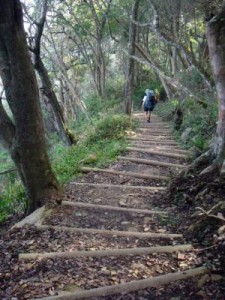
The soils of these forests are generally acidic and nutrient-poor (Van der Merwe 1998). Much of the Knysna forest occurs on gentle to moderate slopes, ranging from 5 m to 1,220 m above sea level (a.s.l.) with a mean of 240 m, while the forests of the Amatole Mountains are situated at higher altitudes, between 700 m and 1,250 m, with a mean of 1,000 m (Geldenhuys 1989).
Rain falls throughout the year in the region, with maxima in early and late summer (Geldenhuys 1989). Mean daily maximum and minimum temperatures in the Knysna are 
Although climatic factors appear to be responsible for large-scale forest distribution, small-scale patterns are determined primarily by fire (Midgley et al. 1997). Forest species will readily invade neighboring fynbos when fire is excluded (e.g. Luger and Moll 1992). Isolated patches of fynbos within the Knysna forest are thought to have resulted from post-glacial forest expansion (Midgley and Bond 1990, Geldenhuys 1989). Charcoal is often found in these forests (Scholtz 1983), suggesting that they do burn, although little is known of their fire regimes (Midgley et al. 1997). Many forest plant species can sprout in response to disturbance (such as fire or treefall) and as a normal process of vegetative recruitment (Midgley and Cowling 1993).
Most trees here are of tropical origin, although members of an older local non-tropical floral 
Biodiversity Features
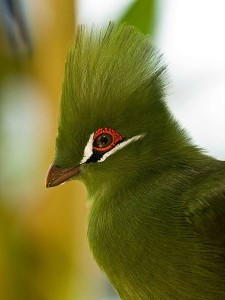
Photo: Su Neko
Perhaps the most famous inhabitants of the Knysna forests are the remnants of the southernmost population of African elephant (Loxodonta africana). During the 18th and 19th centuries, many elephant and buffalo (Syncerus caffer) roamed the coastal plains and mountainsides of the southern Cape, taking refuge in the forests from hunting, habitat destruction and farm expansion. Ultimately, these human influences destroyed the herds (van der Merwe 1998). The last buffalo was shot in 1883 (van der Merwe 1998), and the elephants fared only a little better. Of roughly 500 elephants in the 1860s, just 12 remained by 1920. In 1970, that number was ten; by 1990, only four (Vermeulen 2000). Until recently, it was believed that only one elephant, an elderly cow, remained (Panafrican News Agency 2000). In early October 2000, however, a young bull was photographed in the forest.
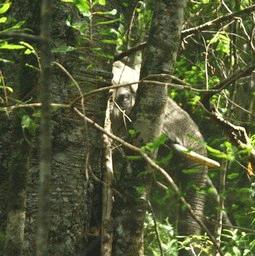
Photo: Wilfred Oraai, SANParks
In spite of this discovery, the future of the Knysna forest elephants looks bleak. Attempts to supplement elephant numbers through introductions have failed, probably because the poor quality of food in the forests compelled the newcomers to leave in search of better forage, often on neighboring farms. The inadequate quality of forest forage may also explain the elephants’ poor reproductive performance and subsequent population crash in the 1970s (Vermeulen 2000). Human presence in the surrounding landscape prohibits the forest elephants from seasonally migrating as their ancestors once did to more nutritional feeding grounds (Vermeulen 2000). The eradication of elephants has undoubtedly altered the
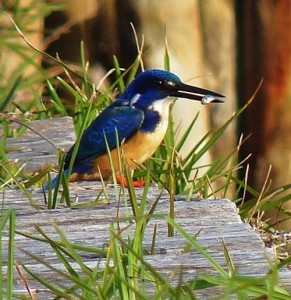
Photo: David Siu
natural processes in this ecosystem as elephants (Loxodonta africana) once caused many treefall gaps by destroying trees of particular species (Von Gadow 1973).
The Knysna-Amatole Montane Forests are part of the Afromontane archipelago-like regional center of plant endemism (White 1983). Current wisdom indicates, however, that on the smaller scale of this ecoregion, tree endemism is low, and few species are rare (Midgley et al. 1997). Other studies in highly fragmented habitats around the world have found that fragmentation is often a driving force in speciation; therefore, endemism in these forests may be higher than is currently now believed. These forests are home to five mammal species listed in the South African Red Data Book (Castley 2001). These are the tree hyrax (Dendrohyrax arboreus), samango monkey (Cercopithecus mitis), blue duiker (Cephalophus monticola), giant golden mole (Chrysopalax trevelyani) and honey badger
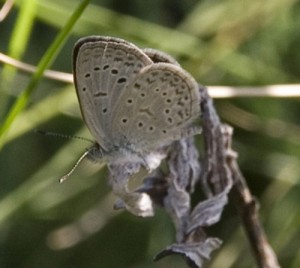
Photo: Sandy Rae
(Mellivora capensis) (Castley 2001). One small mammal is largely confined to this ecoregion, is the long-tailed forest shrew (Myosorex longicaudatus, VU) (Hilton-Taylor 2000).
Among the birds, the Knysna lourie (Tauraco corythaix), Knysna warbler (Bradypterus sylvaticus, VU), Knysna woodpecker (Campethera notata), chorister robin-chat (Cossypha dichroa) and forest canary (Serinus scotops) are all near-endemic to this ecoregion. Other birds found here include the emerald cuckoo (Chrysococcyx cupreus), redchested cuckoo (Cuculus solitarius), greater doublecollared sunbird (Nectarinia afra), spotted flycatcher (Muscicapa caerulescens), sombre bulbul (Andropadus importunus), and the tambourine dove (Turtur tympanistria).
These forests are also home to the strictly endemic Knysna dwarf chameleon (Bradypodion damarnum) (Van der Merwe 1989). The distributions of a number of amphibians are also centred around the Knysna and Amatole forests, and three species are regarded as strictly endemic. Amphibian species restricted mainly to the Knysna forests include the treefrog, Afrixalus knysnae, the southern ghost frog (Heleophryne regis) and plain rain frog (Breviceps fuscus) (Passmore and Carruthers 1995). The Amatole toad (Bufo amatolicus) and hogsback frog (Anhydrophryne rattrayi) are found mainly in the Amatole forest. Habitat degradation, alien plants and forestry activities threaten both species (Passmore and Carruthers 1995). It is not only alien plants that threaten the local fauna and flora. For
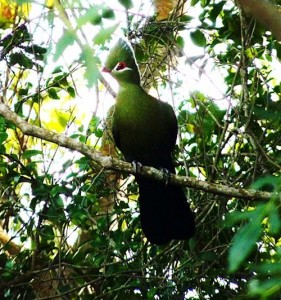
Photo: David Siu
example, the spread of the aggressive Argentine ant (Iridomyrmex humilis) poses a serious threat to the swift moth (Phalaena venus).
Solitary, secretive, and nocturnal, the leopard (Panthera pardus) is the largest predator of the Knysna forests. Its varied diet ranges from larger animals such as bushbuck (Tragelaphus scriptus), chacma baboon (Papio ursinus), and bushpig (Potamochoerus larvatus) to smaller animals including mice (Van der Merwe 1998). In the Amatole forests, however, recent intensive surveys have failed to find evidence of leopards, indicating that they may be extinct here (Castley 2001). Other mammalian predators include caracal (Felis caracal), honey badgers, and large-spotted genet (Genetta tigrina).
The crowned eagle (Stephanoaetus coronatus), a large and agile bird capable of preying on monkeys and small antelope, and the wood owl (Strix woodfodii) are among the larger avian forest predators. Most snakes occurring here are not poisonous, and those that are 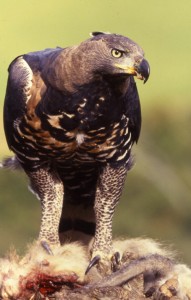
Current Status
These forests have a long history of human inhabitation and utilization. Major exploitation of the Knysna forests began in the 1700s (Phillips 1931, 1963), and in 1891 in the Amatole forests (Castley 2001). The settlers not only harvested timber, but also cleared portions for crops and grazing (Geldenhuys 1989). In response to the continuing destruction, the forests were closed to exploitation in 1939, but re-opened in 1965 for exploitation by the state under control of forestry scientists (Von Breitenbach 1974).
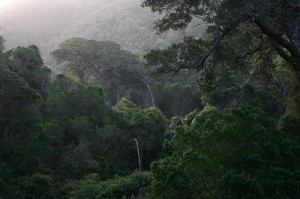
Photo: Andro Strachys
Both publicly owned and many privately owned forests are now in an advanced state of recovery from past timber exploitation. Many of these forests are run with a policy to rehabilitate destroyed forests, consolidate existing forest patches by reconverting abandoned plantations or forest margins to manageable boundaries, and to eliminate alien vegetation (Geldenhuys et al. 1986). The removal of natural resources is usually systematic and controlled. Sustainable timber harvesting is currently practiced according to the Senility Criteria Yield Regulation System. Monitoring is vital to ensuring that harvesting is sustainable when it deviates from the natural disturbance regime, e.g. commercial harvesting of seven-weeks fern for floristry. The Knysna forests are managed for nature conservation, sustained use of forest products and outdoor recreation. In the 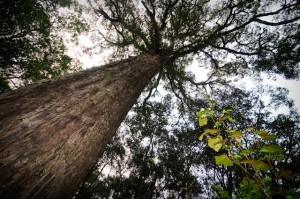
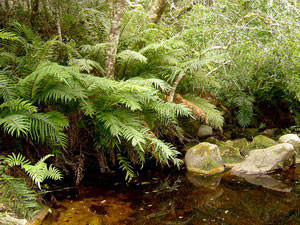
Most plant and animal species of these forests are common and widespread. This helps ensure that they are well represented in formal conservation areas (Geldenhuys and MacDevette 1989). Moreover, many of the vertebrates are not restricted to this habitat. For example, leopard, caracal, honey badger and bushpig as well as many of the bird and snake species are also found in other habitats (Geldenhuys and MacDevette 1989).
Types and Severity of Threats
These forests have a long history of human use and habitation. While they are small and 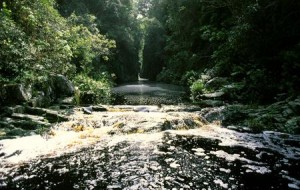
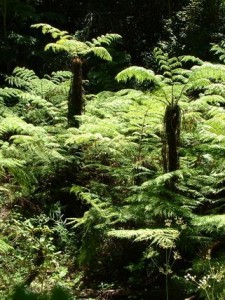
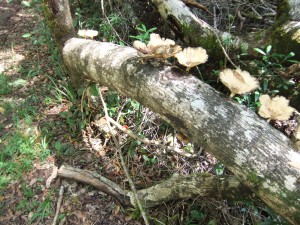
Justification of Ecoregion Delineation
The Knysna-Amatole Montane Forests ecoregion forms the southermost extent of the Afromontane archipelago-like regional center of endemism (White 1983). It also represents the largest area of afromontane forest in the region (Low and Rebelo 1996), and thus was distinguished as a separate ecoregion. It also forms part of the South African Forests Endemic Bird Area (Stattersfield et al. 1998) and Afromontane Regional Center of Plant Diversity (WWF and IUCN 1994).
Harvesting
Indigenous timber is now harvested at a rate of no more than 2m3 (1 tree) per hectare. The process – called the “mortality harvesting pre-emption system” – is strictly controlled by Government and seeks to emulate the forests’ natural cycle. Only trees which can be 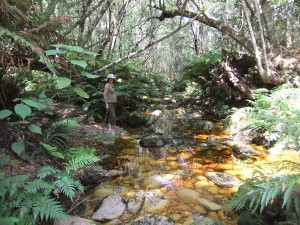
Apart from this limited harvesting, our indigenous forests are now protected and will remain so for generations to come.
Conservation
Both publicly owned and many privately owned forests are now in an advanced state of recovery from past timber exploitation. Many of these forests are run with a policy to rehabilitate destroyed forests, consolidate existing forest patches by reconverting abandoned plantations or forest margins to manageable boundaries, and to eliminate alien vegetation. The removal of natural resources is usually systematic and controlled. Sustainable timber harvesting is currently practised according to the Senility Criteria Yield Regulation System. Monitoring is vital to ensuring that harvesting is sustainable when it deviates from the natural disturbance regime, e.g. commercial harvesting of seven-weeks 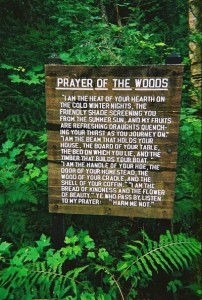
Overall, the outlook for future protection and conservation of these forests is encouraging: in Knysna, public conservation and local authorities actively manage over 70 percent of the total indigenous forest area, and nearly 20 percent is conserved in proclaimed nature reserves and national parks.
Plantation Forestry
South Africa’s plantation forests cover nearly 1.5 million hectares, or 1.2% of the country’s total land mass. The Cape Province has about 84 000 ha of plantations, much of which occurs in the Southern Cape. The preferred species in this area is the softwood Pinus Radiata – the Monterey Pine.
References
South African National Parks (SANParks)
>Acocks, J. P.H. 1953. Veld types of South Africa. Memoirs of the Botanical Survey of South Africa 28.
Castley, G. Eastern Cape forests. Retrieved (2001) from: http://zoo.upe.ac.za/postgrad/guy/ecape.htm.
Geldenhuys, C. J. 1982. The management of the southern Cape forests. South African Forestry Journal 121: 1-7.
Geldenhuys, C. J. 1989. Environmental and biogeographic influences on the distribution and composition of the southern Cape forests (Veld type 4). PhD thesis, Department of Botany, University of Cape Town.
Geldenhuys, C. J. and C. J. Van der Merwe. 1988. Population structure and growth of the fern Rumohra adiantiformis in relation to fern harvesting in the southern Cape forests. South African Journal of Botany 54: 351-362.
Geldenhuys, C. J., P. J. Le Roux, and K. H. Cooper. 1986. Alien invasions in indigenous evergreen forest. Pages 119 – 131 in I. A. W. MacDonald, F. J. Kruger and A. A. Ferrar, editors. The ecology and management of biological invasions in southern Africa. Oxford University Press, Cape Town.
Hilton-Taylor, C. 2000. 1998. The IUCN 2000 Red List of Threatened Species. IUCN, Gland, Switzerland and Cambridge, United Kingdom.
Luger, A. D. and E. J. Moll. 1992. Fire protection and Afromontane forest expansion in Cape Fynbos. Biological Conservation 64: 51-6.
McKenzie, B. editor. 1988. Guidelines for the sustained use of indigenous forests and forest products. Occasional Report No. 35, Ecosystem Programmes, CSIR, Pretoria.
Midgley, J. J. and R. W. Cowling. 1993. Regeneration patterns in Cape sub-tropical transitional thicket: where are all the seedlings? South African Journal of Botany 59: 496-499.
Midgley, J. J. and W. J. Bond. 1990. Knysna fynbos “islands”: origins and conservation. South African Forestry Journal 153: 18-21.
Midgley, J. J., R. M. Cowling, A. H. W. Seydack and G. F. van Wyk. 1997. Forest. PAGES 278-299 in R. M. Cowling, D. M. Richardson, and S. M. Pierce, editors. Vegetation of Southern Africa, Cambridge University Press, Cambridge, United Kingdom.
Milton, S. J. 1987a. Effects of harvesting on four species of forest ferns in South Africa. Biological Conservation 41: 133-146.
Milton S. J. 1987b. Growth of seven-weeks fern (Rumohra adiantiformis) in the southern Cape forests: implications for management. South African Forestry Journal 143: 1-4.
Panafrican News Agency. 2000. Rare Knysna Elephant spotted. Retrieved (2000) from: http://allafrica.com/stories/200010040045.htm.
Passmore, N. I. and V.C. Carruthers. 1995. South African frogs. Southern Book Publishers and Witwatersrand University Press, Johannesburg.
Phillips, J. 1963. The forests of George, Knysna and the Zitzikama – a brief history of their management 1778 – 1939. Government Printer, Pretoria.
Phillips, J. F. V. 1931. Forest succession and ecology in the Knysna Region. Memoirs of the Botanical Survey of South Africa 14.
Rutherford, M. C. and R. H. Westfall. 1986. Biomes of southern Africa – an objective categorization. Memoirs of the Botanical Survey of South Africa 54.
Scholtz, A. 1983. Houtskool weerspieël die geskiedenis van inheemse woude. Bosbounuus 3: 18-19.
Van Dijk, D. 1987. Management of indigenous evergreen high forests. Pages 454-464 in K. Von Gadow, D. W. Van der Zel, A.Van Laar, A. P. G. Schönau, H.W. Kassier, P. W. Warkotsch, H. F. Vermaas, D. L. Owen, and J. V. Jordaan, editors. South African Forestry Handbook. Southern African Institute of Forestry, Pretoria.
Van der Merwe, I. 1998. The Knysna and Tsitsikamma forests: Their history, ecology and managment. Department of Water Affairs and Forestry, Knysna, South Africa.
Vermeulen, C. 2000. The Knysna Elephant: Today only one Knysna elephant remains: What happened? Retrieved (2000) from: http://www.fstcu.org/news/nrnews1.htm#iSection.
Von Gadow, K. 1973. Observations on the utilization of indigenous trees by the Knysna elephants. Forestry in South Africa. 14: 13-17.
Von Breitenbach, F. 1974. Southern Cape forests and trees: a guide. Government Printer, Pretoria.
White, F. 1983. The vegetation of Africa, a descriptive memoir to accompany the UNESCO/AETFAT/UNSO Vegetation Map of Africa (3 Plates, Northwestern Africa, Northeastern Africa, and Southern Africa, 1:5,000,000). UNESCO, Paris.
WWF and IUCN. 1994. Centres of plant diversity. A guide and strategy for their conservation. Volume 1. Europe, Africa, South West Asia and the Middle East. IUCN Publications Unit, Cambridge, U.K.
Prepared by: Colleen Seymour
Reviewed by: In progress
For more general information on this ecoregion, go to the WildWorld version of this description.
All text by World Wildlife Fund © 2001
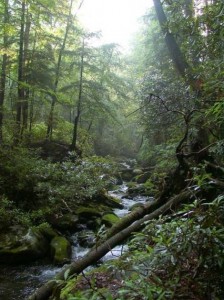 Conservation of the Knysna forests
Conservation of the Knysna forests